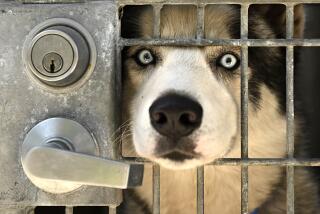Detroit Goes Rabid Over Feral Dogs
- Share via
DETROIT — Johnnette Rule knows too well how her job can become a real dogfight--like the day the 10-year mail carrier had to use her satchel to fend off a stray German shepherd.
Whether born on the streets or turned away from homes, wild dogs or their predecessors once were pets. But when they run in groups, they cause a lot of grief.
“We’ve had carriers who have had plugs torn out of their arms and legs, many who have had their clothes torn by dogs,” Rule said. “It’s really ugly.”
And it’s not just in Detroit.
In March, an Illinois farmer received $1,300 from the state, compensation for 26 pigs killed in 1993 by a pack of wild dogs. Dogs killed two ostriches in Oregon, fatally attacked a $15,000 horse in Tennessee and joined coyotes in killing livestock and pets in Colorado.
In the past year, a small pack of stray dogs attacked and injured a Massachusetts boy on his way to a school bus stop. In Oklahoma City, front-porch mail delivery in some neighborhoods was halted after dogs attacked several carriers.
Postal Service spokesman Mark Saunders says dogs attack 2,700 letter carriers across the country each year, costing taxpayers about $25 million for medical expenses and substitute carriers. He didn’t know how many of those attacks were by wild dogs.
In Detroit, the dog menace is considered so bad that the city’s postmaster threatened to stop delivering mail to some areas.
“People are saying that because of the dogs, they’re sometimes trapped in their homes,” said Donyale Stephen, an assistant city ombudsman.
Of the top 10 complaints to the office, roaming dogs were third this year. Dogs had never before been on the 24-year-old list.
The city’s Animal Control Division recently got four new vehicles to boost its dog-catching ability.
“We’ve been trying to get as many dogs off the street as we can,” Donald Hamel, the animal control office’s supervisor, said.
His division has made arrangements for two more animal control officers, he said, although they weren’t included in the budget, to bring the total to 15. They are responsible for 144 square miles in the city of 1 million people.
Officers can snare individual dogs, but must work as a group to round up packs that are drawn together by a female dog in heat.
“We can have packs of dogs up to 20. We can’t always get them all,” Hamel said.
Though Detroit’s exact population of feral dogs isn’t known, evidence of the crackdown is. Animal control workers caught 919 dogs from July through September of last year.
Through this year’s first three months, crews caught 1,532.
In January, city Postmaster Lloyd Wesley Jr. asked Mayor Dennis Archer and the City Council to take action with “grave urgency.” Since meeting with Detroit health officials, Wesley said the problem has eased, thanks partly to animal control’s efforts.
Nevertheless, the issue still lacks priority in terms of funding. In his budget proposal for next year, Archer has rejected a request by Hamel’s office for two more workers and the health department’s call for $600,000 more for animal control.
What’s more, city plans for widespread razing of abandoned buildings where dogs seek shelter could force more of them onto the streets, observers say. And an outbreak of distemper--a highly contagious virus that makes dogs deranged and hasn’t been seen locally since the 1980s--only adds to potential problems: The animals already might carry rabies.
“Unfortunately, a lot of people in this city haven’t gotten the message that their dogs should not run loose,” said Sherry Silk, director of the Michigan Humane Society’s Detroit office.
Yet the dogs still roam. In her Detroit neighborhood, Lovie Barrow, 80, sees dog packs prowling so often that “I’ve gotten used to them, I guess.”
In a rundown garage across the street, she spots a gaunt, mangy German shepherd and two other strays.
Said Barrow: “When the dogs are around, I seldom go outside unless I’m going to my car.”
More to Read
Sign up for Essential California
The most important California stories and recommendations in your inbox every morning.
You may occasionally receive promotional content from the Los Angeles Times.













